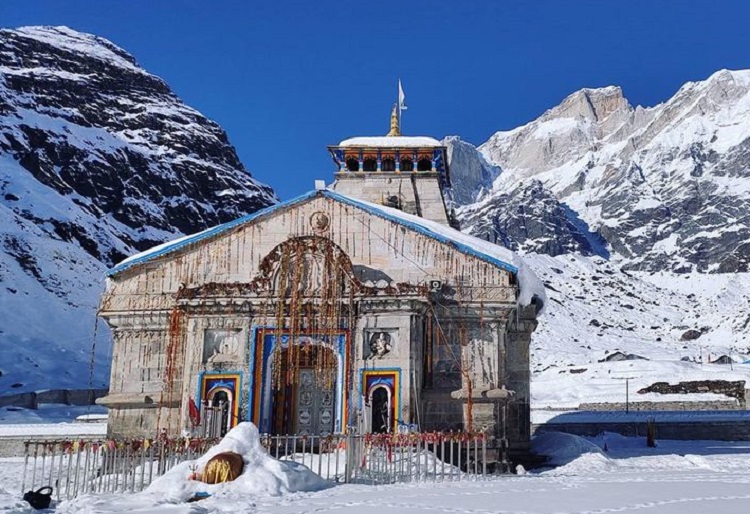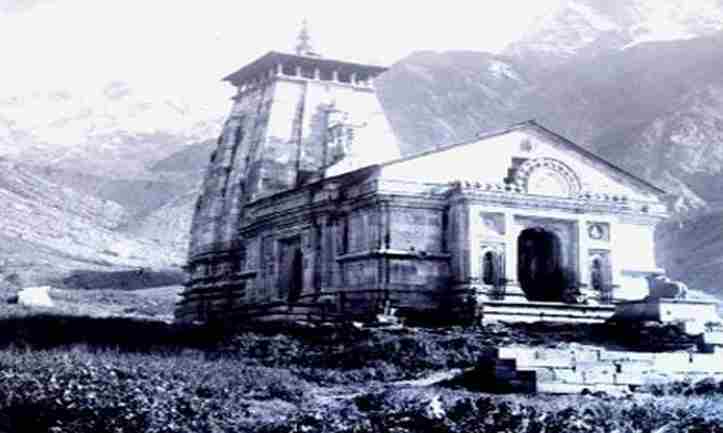Last Updated on March 23, 2024
Kedarnath Temple is one of 12 Jyotirlinga dedicated to Lord Shiva, in the lap of the Himalayan mountains (Garhwal) in Rudraprayag district of Uttarakhand on the shores of Mandakini river, is also one of the Char Dham and Panch Kedar. It is at a height of 3,583 m (11,755 ft) and a distance of 223 km from Rishikesh Kedarnath shrine and temple is surrounded by mountains on three sides. On one side is Kedarnath, which is about 22 thousand feet high, on the other side is 21 thousand 600 feet high Kharchakund and on the third side is 22 thousand 700 feet high Bharat Kund.

The beauty of the temple is just breathtaking, Kedarnath Temple is not only encompassed by three mountains but also is the confluence of five rivers – Mandakini, Madhuganga, Sir Ganga, Saraswati, and Swarna Gowri. Some of these rivers no longer exist but river Mandakini is still present there.
This is the largest Shiva Temple in Uttarakhand and situated is the highest temple amongst 12 Jyotirlinga, which is built by adding huge boulders from Qatwan. These boulders are brown. The temple is made about 6 feet high. Its sanctum is ancient, which is considered to be about the 8th century.
The History of Kedarnath Jyotirlinga Temple

The time when the Mahabharata war was over and the five Pandavas were reviewing the war with Lord Krishna. Krishna told the Pandavas that even though they are victorious in the war, they have become a part of sin due to killing the Gurus and their brothers and sisters. It is impossible to get rid of these sins. On this, the Pandavas asked for a solution to get rid of sin.
Lord Krishna said that only Mahadev (Lord Shiva) can give salvation to your sins, so go to the shelter of Mahadev. When Mahadev got the information that Pandavas are approaching him, he became cautious. To prevent the Pandavas from coming in front of them, he began to change places over and over again because Mahadev was angry with the Pandavas for killing the brothers and for getting the state.
Pandavas were also determined that in every situation they have to get Mahadev and find out the way to their liberation. Pandavas, following Mahadev, reached Kedarnath. Mahadev saw that Pandavas had come to Kedarnath, then he started thinking of solutions to hide, all of a sudden Lord Shiva saw a herd of buffaloes and he joined the herd as a bull to hide his identity.
It was difficult for Pandavas to recognize Mahadev from the herd of buffaloes. Mahabali Bhim then stood between two mountains. All the other brothers started checking buffaloes from the middle of Bhima’s feet. All the buffaloes ran under the feet of Bhima, but Mahadev was uncomfortable crossing beneath the foot of Bhima Lord Shiva stopped there and the Pandavas recognized Shiva.
Just what was it, Mahadev used to assemble in the form of a bull. Bhima caught hold of the Goddess of the bull as soon as possible. Mahadev was forced to appear and had to be free of sin by seeing the determination and determination of the Pandavas. Even today, the evidence of this incident is present in Kedarnath Shivling as a bull’s hut.
Shiva started revising his face in the earth and took out the part of his head in Nepal, which is worshipped as Pashupatinath. Shiva’s arms appeared in Tungnath, the face in Rudranath, Stomach, and Naval in Madhyamaheshwar, and hairs (Tresses) in Kalpeshwar. All these are known jointly by the name of Panch Kedar.
Construction of the Kedarnath Temple
According to some people, this temple was built by the Adi Shankaracharya in the 8th century. It is said that Pandavas had built a temple right behind the existing Kedarnath temple, but that could not bear the brunt of the time and was destroyed. Many other facts are there regarding the construction of the temple but no solid proof is recorded. However, according to Garhwal Vikas Nigam, the present temple was built by the Adi Shankaracharya in the 8th century AD. That is, this temple had already been built before the period of the small ice age which began in the 13th century AD.
Due to the unfavorable climate here, this temple is open for visitors from April to November. However, during winters, the deities from Kedarnath are brought to Ukhimath which is at 1311 meters and 41 km from Rudraprayag. Lord Shiva is worshipped here in the winter season.
Reaching Kedarnath is not easy, no vehicle directly goes there, and it is a 13-14 km uphill trek that starts from Gaurikund. However, the way goes through Rishikesh, Devprayag, and Rudraprayag and ends in Gaurikund. Pony and Manchan services are available to reach.
How to Reach?
Buses: You can take the bus to Haridwar to reach Gaurikund.
Railway: Nearest railway stations are Rishikesh (215 kms), Haridwar (241 kms), Dehradun (257 kms), and Kotdwar (246 kms)
The nearest Airport is the Jolly Grant Airport near Dehradun which is 239 km from Kedarnath. This airport is closer to Rishikesh (approx. 16 km) and takes roughly 20-30 minutes to reach Rishikesh.
Other places to see near Kedarnath Jyotirlinga:
- Gandhi Sarovar: A small lake
- Shankaracharya Samadhi: A relaxing and serene location for visitors.
- Bhairavnath Temple: Located 1 kms from the Kedarnath Temple.
- Ratus Kund: It is a small Kund (water source) around 200 mts from Kedarnath temple.
- Gaurikund: Base for a trek to Kedarnath
- Vasuki Tal: 6 km. At 4135 meters. above sea level, this lake is amazing
- Sonprayag
Trekking near Kedarnath Dham
- Vasuki Tal (6 kms): This trek is 6 kms from Kedarnath Temple with panoramic magnificence.
- Chorabari Tal (3 kms): It is a small lake connected with Chorabari glacier in the foundation of Kedarnath Parbat.
- Bhairon Temple (1 km): It is a small trek to the nearby Bhairon Mandir.
Festivals Celebrated in Kedarnath Temple
Vinayaka Chaturthi and Deepawali are celebrated here during September and October-November.
Shravani Annakoot Mela is celebrated on the day before Raksha Bandhan usually celebrated in August.
Special Samadhi Pooja is held on the closing day of Kedarnath temple.
Suggested Posts
10 Devi Temples in Uttarakhand
Best Places to Visit in Agra
Things to Do in Dwarka and Somnath
Things To Do In Darjeeling
Best Wildlife Experiences in Sri Lanka

